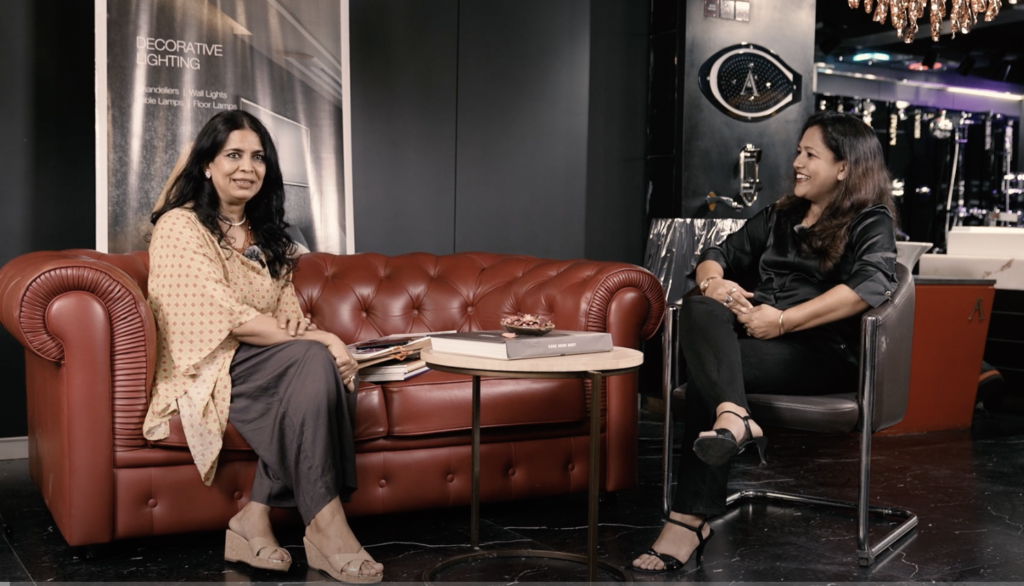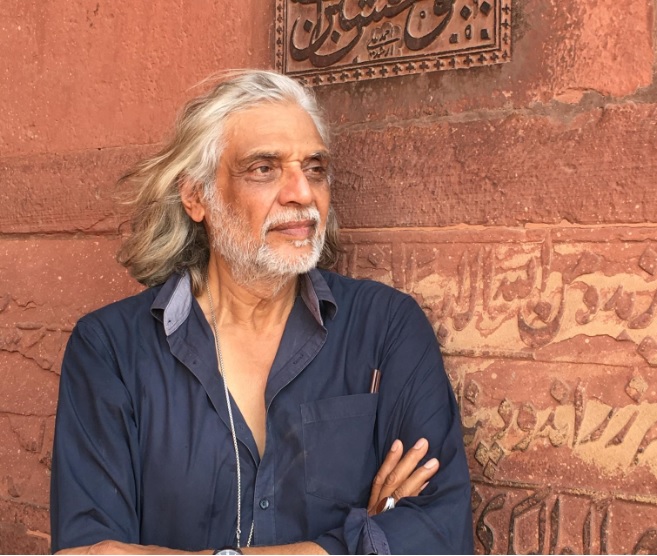Welcome to Samvaad, where art meets conversation, and inspiration knows no bounds. Here we engage in insightful conversations with eminent personalities from the art fraternity. Through Samvaad, Abir Pothi aims to create a platform for thought-provoking discussions, providing readers with an exclusive glimpse into the creative processes, inspirations, and experiences of these creative individuals. From curating groundbreaking exhibitions to pushing the boundaries of artistic expression, our interviews shed light on the diverse perspectives and contributions of these art luminaries. Samvaad is your ticket to connect with the visionaries who breathe life into the art world, offering unique insights and behind-the-scenes glimpses into their fascinating journeys.
In this enlightening dialogue between esteemed architect Nomita Goswami and visionary entrepreneur Ruby Jagrut, we gain profound insights into the dynamic landscape of architecture and design. Nomita Goswami, renowned for her innovative architectural approach and meticulous attention to detail, brings forth her extensive experience and nuanced perspective on the evolving trends in the industry. On the other hand, Ruby Jagrut, the pioneering force behind Abir India, is celebrated for her commitment to seamlessly blending traditional craftsmanship with contemporary aesthetics. Together, they engage in a thought-provoking conversation exploring the intricacies of client dynamics, the evolving role of designers, and the impact of cultural awareness on architectural projects. Join us as we delve into their captivating exchange, navigating through the intersections of culture, creativity, and craftsmanship.
Ruby: Hello and welcome to Samvaad at Jaguar, I am Ruby Jagrut and I am very excited to present Nomita Goswami here. She’s been practising interior design for the last 20 years. Welcome, Nomita. Welcome to Samvaad.
Nomita: Thank You.
Ruby: She studied IFT in Guwahati and has been practising for the last 20 years. Welcome! So, how did things start for you? Tell us, where did your journey begin and how did you decide to become an interior designer?
Nomita: Well, actually, I mean, from childhood itself, I had a habit of decorating a type of house, meaning any artwork, I had a lot of interest in this type. Then, after completing my graduation, the reason for doing a master’s was, meaning, I felt like doing an interior design course. So, accordingly, I started studying at IFT. After that, I was in the middle of a six-month course. After six months, I had a project come up, meaning, like someone said, “If you can do such and such work,” then our line is such that it won’t just happen with studies, your practical knowledge is very important. So, I also said yes and started. So, from that time onwards, after that, I did a two-year diploma course at IFT. So, from that day onwards, the work started.
Ruby: So, Nomita started working even before she had a degree. Good beginning. And what memories do you have about your first project? Please share.
Nomita: You know, hearing about my first project will sound quite different. At that time, while I was doing the interior designing course at IFT, my classes used to be in the evening, and at the same time, I had a job at an Indian startup. So, it was my first job, right? It didn’t feel right to refuse, so I said yes. So, my journey from that day is so memorable, you can’t imagine. I took classes until evening, then went to Shivsagar the next day in the morning, reached there by 3:00 PM, stayed there until 7:00 PM, and then again went there in the morning. So, after that, I started working there. Actually, it wasn’t a very big project. It was just a bungalow. But it was their first project, meaning, the entire paint on the outside and inside, meaning, both sides of the paint. First, they were talking about the furniture, which I will select later. Starting means, like even selecting a paint properly is very important. So, I went there and selected everything, then came back in the evening, then went back in the bus. Came back at 6:00 in the morning, then came back to class at 9:00, then came back again. So, I went to the institute again that day. It was such that I couldn’t be absent from anything. You won’t believe it, but there was money in it, like the work. Okay, there was money too, but my project was such that I didn’t say anything, but I got a lot of good money. I mean, it feels good, right? Starting means, you’re happy right away. Not like nowadays, where people think if they’re not getting work, whatever money they get, they take it. Even if it’s a very small amount, we people, who are interning with me right now, say, according to that, I took it. But my lucky thing was that it seemed like I got a lot of good amounts without saying anything, and they were also very satisfied with the work. It was a small job, but they were very happy.
Ruby: Your beginning was very positive, you had a great time, and you also earned good money. So, since that day till now, have you done any residential projects? You’ve done a lot of work in hospitals, including landscaping. So, out of all these projects, what do you enjoy doing the most?
Nomita: Actually, I enjoy working on residential projects more, especially bungalows where you can properly, like, have full landscaping or design the entire house together with a theme. We can work with a theme because in a flat, you don’t get much space to showcase your creativity, but in a proper bungalow, when you design everything from landscaping to the entire bungalow, that’s when your design stands out. But even in small-sized projects, we try to excel in everything, but there’s a bit more fun in that.
Ruby: You enjoy working on residential projects, and if I may ask, when you have a client, what is your initial approach? What would be your first question to them? What will be your process? How do you decide on the theme if you’ve said “theme-based”? How do you decide on the theme, and how do you design it?
Nomita: Yes, you see, it’s like once we start talking, we ask them about their preferences. What type of design do they like? Whether it’s modern, a bit vintage, or any other type they prefer. Second, we inquire about their budget because any design has to be done according to their budget, so we need to consider that. So, I gather information about their budget and preferences. Then, based on that, I provide them with a design so that their home or whatever project it may be, is tailored to their liking and budget.
Ruby: Alright, so when a residential project comes to you, you want to know the family’s likes and dislikes, how many people will be living there, how they will use the space—all the basic information. And along with that, very important questions like what should the budget be. When you’re designing based on this budget and other factors, I’m an artist, I run an art foundation, so I will definitely ask you, do you think any project can be completed without art?
Nomita: No, never.
Ruby: So, that was a rather selfish question, and I asked you because in our conversations, we try to understand how architecture, interior spaces, and art can come together to enhance each other, or what kind of relationship should exist between interior designing and art from your perspective. How you bring art into your projects and where your involvement with art begins in the context of your projects. Can you elaborate on all of this in detail?
Nomita: Yes, so as I mentioned earlier, our design depends on the client’s choice. For example, whether it’s a modern or vintage design, we start the work accordingly. It also depends on what kind of art theme we can incorporate into modern themes, such as having some modern paintings and wall decor, and some designing in modern art styles. In vintage themes, there are also many options available for art. So, according to the client’s preferences and timing, we work. One problem we face is that for proper art, a project takes some time. Even if we work with an artist, it’s not like we can finish the work in two days. We have to give them some time. However, there are some items in the market that can be completed within two days’ work. Sometimes, even if we want to, we can’t implement the art because it requires some time, and sometimes we get a project that needs to be completed within a particular time frame, so even if we want to implement it, we can’t. And when we get the proper time, we make every effort to implement it thoroughly.
Ruby: If you have implemented a project as you mentioned, where you have worked with an artist, then tell us about such a project. Share some details about a project in which you collaborated with an artist to implement it.
Nomita: Actually, as I mentioned earlier, back when I was still studying, wallpapers were not as readily available as they are today for decoration. So, mostly, we used to rely on paint for the design. For instance, if we were to design a restaurant, we would work on the wallpaper design first, and then select furniture that would complement it, trying to give it an artistic look. Similarly, when it came to homes, we could paint or do wallpaper decoration entirely through paint. Whatever the case, we would also incorporate other artistic elements. However, nowadays, there is a slight decrease in such options, but still, during that time, I had worked on some projects like landscaping. For instance, I worked on creating a waterfall through an artist’s help in Arunachal, where the entire house was like a fortress. In that, I created a waterfall through an artist, which looks so realistic that you can’t tell it’s artificial. I have also done a lot of artwork in hotel projects, such as in the lobby and gardens, incorporating artwork from the fountain, not just installing a ready-made one.
Ruby: So, the art installed in the form of an installation, which serves the purpose of a fountain, was it done by an artist?
Nomita: Yes, exactly. Like the entire fort, which you might think has a waterfall flowing from the top of a mountain, but it’s entirely made of stone, and then art has been worked on it. I have done similar work in the lobby area of hotels, in the lobby area of hotels as well. Then I worked on government projects like the State Bank of India, all of them, like in the CGM’s (Chief General Manager) quarter or their SBI main office, your conference room, all of them have artwork. And like the notes, it’s not just artwork in terms of painting, it’s the other things we get here, like notes, products, textiles, or whatever it is, I have done a lot of design work by mixing all of them.
To be continued…





